Bushcraft in Lassen National Park
2013-08-28
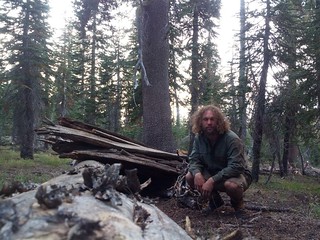
After my swiftwater class I wandered my way north on 49. I don't really have a reason, it's just what happened. Eventually I found myself outside Lassen National Forest. I stopped by a ranger station and picked up some large-area maps, they aren't topo, but they have all the little roads.
I decided to park in the Forest just outside the park and hike in on a trail that was supposedly there. Longtime readers may remember my last
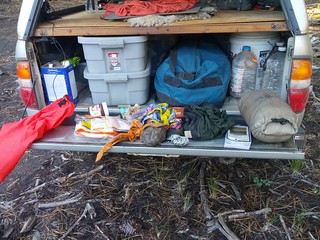
packlist
- external frame pack
- drysack
- sleepingbag
- wool sweater
- sorong
- jurkey, 2/3 jar of nutella, tortillas, 4 energy bars, small bag of nuts
- Emergency bivy
- Basic repair/fire stuff (firestarting, sharpener, needle, spare meds, etc.)
- belt knife
- ~40 ft of twine
- compass
- monocular
- rock-salt
- stainless steel water bottle
- plastic water bottle
- cellphone
- meds
- wool socks
- shorty gators
- cotton canvas shorts
- cotton/polyester blend canvas shirt (5.11)
You'll note a lack of things like shelter, raingear, much warm clothing, a sleepingpad, or any cooking equipment. It had been cold the night prior (not sure how cold, but pretty chilly, maybe 40s), so I wanted a sleepingbag as backup just in case.
I had a pretty fun hike. It was hot so I was shirtless the whole first day exploring the cindercone, lavaflows and such. I was also in search of volcanic glass, you can see how it could form. This is closer to a chert, but you can see that it's starting to break the right way. It's got too many bubbles and is too inconsistant to be useful though, sadly.
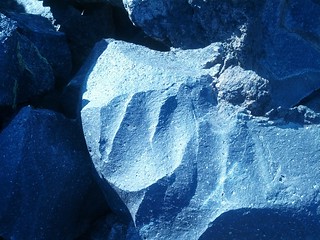
During the hike someone asked me if it was worth hiking to the top of the cindercone. Judge for yourself
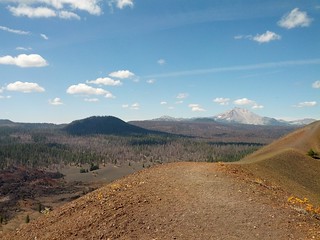
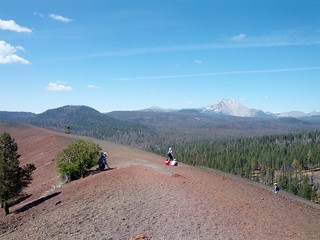
I got kindof sunburned actually. Once I realized this I started looking around and saw some mule's ear. I chewed it up, spit it out and put that on it. I knew mule's ear wouldn't hurt me to chew, and that when you mush it up it gets kindof gummy so might work like other moisturizers. It worked quite well. The burn hurt a bit to touch, and that evening and the next day it wasn't even red.
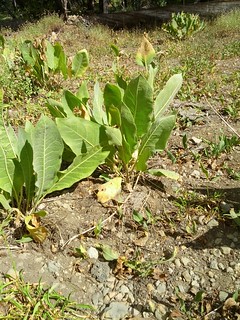
I also found some delicious Gooseberries. Yum! These might actually better be called currents (they are closely related) in any case, they were delicious.
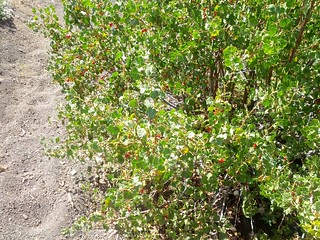
Lassen is hard hiking due to the sand, especially in the northeast side where the cindercones all blew their tops. After maybe 14 miles I was sufficiently exhuasted that it was time for bed. I got out to national forest again (still many miles from my truck). The sky was threatening so I needed to do something about rain. I had no rain-gear or shelter except an emergency bivy. My backup plan was to slit one side and the bottom of the bivy and string it up as a makeshift tarp using the twine. As it turned out though my shelter worked out great, and only took maybe 2 hours to build.

In the Sierra downed trees often rot so that the middle turns to dust but the outside takes longer. As a result you can pick up these sort of panels of rotting wood. This is about as perfect as you could ask for for shelter building. I found several such trees next to each other and a less-rotton log to use for one side of the shelter.
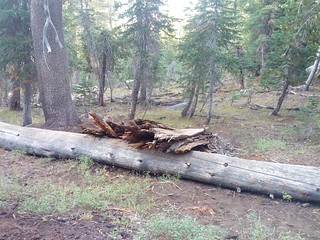
After these pictures were taken I spent some time chinking all the holes. This took at least as long as building the primary shelter. I figured I'd already protected myself from the wind. My goal now was to reduce air circulation so I could actually heat the inside up somewhat and use it as an insulating layer. This sort-of worked, but not as well as I hoped. I'll keep chinking in mind earlier in the process next time. You want it as sealed as possible. If I'd had a shovel I would've burried the whole thing.

I had originally grabbed the sorong for gathering things I found and carrying them. As it happened though it worked perfectly as a door to try and cut down the air circulation further.
I started by trying to sleep in this shelter with just the canvas shirt, shorts, shoes and socks on. That didn't quite work, I was definitely okay and would've probably even gotten a little sleep but I couldn't get comfy. Next I tried putting my wool shirt over my legs... that was a waste of the wool shirt. I swapped the canvas and the wool shirts. I still couldn't get comfortable enough to sleep (I'd been trying for maybe 3 hours by this time, fidgiting with the shelter and tweaking my clothes). So I put on the wool shirt and the canvas shirt over it and I broke out the emergency bivy. I figured I still wasn't using the sleepingbag, I was only using gear I typically carry on a dayhike, so if I actually slept and was happy with that it was an accomplishment. This was downright comfortable! I slept for a solid 3 hours before waking up.
I usually sleep for 3 hour spells when out backpacking. Generally I get up and pee, shift things back into position if I slid down a hill or whatever, roll over, and go back to sleep. So generally I wake up two to three times a night. So 3 hours means everything is hunky-dory for me.
On my next cycle I slept 2 hours. Not bad, but I was starting to get damp from the emergency blanket. I was pretty damp when I got up. The temperature outside was still dropping as well. That said, I had 5 hours of sleep. If I didn't sleep the rest of the night that'd be a pretty good success. I got between an hour and two hours more that night in shorter segments. The last time I got up and went back I shivered for a while in the shelter, but warmed up again in not too long. I finally got up at 7:40 after stalling a bit waiting for it to warm up outside. It was still chilly at this time so I shivered for the first half mile of hiking. I'm always cold when I get up in the morning though and it was a good healthy tooth chatter, I wasn't cramping up at all and it definitely wasn't the nearly hypothermic shiver that threatens to stop if you get colder.
It didn't warm up much the second day. It sprinked several times and actually broke out into an honest-to-goddness rain one time for a couple minutes. I just wore the canvas shirt the whole day buttoning and unbottoning as needed. The rain was short enough that it barely got wet. Had I gotten wet I had the wool shirt, which even soaked would keep me warm enough as long as I'm hiking. Personally I get cold when I sleep and I'm very cold in the morning, but once I'm moving I get very warm.
For me, this trip was a huge step. This is the second time I've ever been comfortable sleeping out in not super-hot weather without a sleepingbag. It's also the first time I've built a shelter on the fly out of need, and the first shelter I've built that I think would have a hope of keeping me dry in a normal rain.
As yet one more bonus I found not only gooseberry and guessed at a sunburn treatment. I also found lichen that you can eat like spaghetti (NOTE: I've never done this, Jess has and explained it to me recently). There's a fire-ban on so I couldn't make a fire to cook it unfortunately. Still, gooseberry and licken for dinner, and a shelter I could've slept in with no other gear and been fine. In short, I almost could've lived a day or two out there.
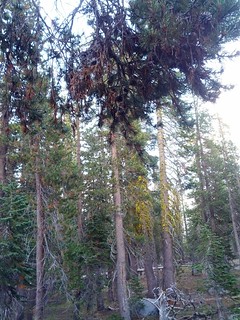
An aside for anyone thinking of doing something crazy like this. I'm not going to say don't try this at home, the point of this blog is largely to encourage people to just try things. But please be careful:
- I know my warmth requirements very well.
- I know my personal signs for hypothermia and am good at recognizing them.
- Note that even with the above I *still* had a sleepingbag, canvas shirt, wool shirt, and emergency bivy. I was hoping to use none of these, and I was very glad I had them.
- I know I can dry out clothes and gear. This is critical for doing without raingear in particular. I discovered accidentally that this isn't true of everyone when my brother's sleepingbag bad been wet for 2 nights running with no change. I slept in it and it was bone dry in the morning.
Just to illustrate that not everything went smoothly, I managed to leave my knife in the shelter. I drove around to the other side of the park and did a midsized dayhike the next day to get it back. Happily I found it though, YAY!
One last thing, I upgraded my phone recently, and now it can do "sphere" photos. Here's the first one I ever took
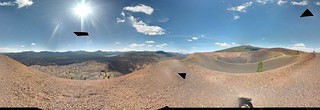
The reason I quit my job
2013-08-28
Surprisingly, I think almost everyone I talked to "got it". I think that's because I hang out with some unusually awesome people. For anyone who didn't though, this is the single best explanation I've seen. Thanks Bill Watterson, you still help clarify life for us all
I don't usually repost, but this is worth it.
http://www.slate.com/blogs/browbeat/2013/08/27/bill_watterson_s_cartoonist_s_advice_in_comic_form_by_zen_pencils_aka_gavin.htmlVixen talking to her kits
2013-08-28
It's pretty hard to hear, it's the best I could get with my cellphone, but if you turn it up and use headphones you should be able to hear it.
I'm pretty sure that this is the sound of a Vixen (female fox) talking to her kits. Each time I heard this sound it was right after almost a peeping sound, the sound of her kit I assume. This would mean that what I was hearing was the sound of kits that were old enough to come out of the den and play, but still young enough that their calls sound like peeps.
This recording was taken just outside of Yosemite on route 140 where I camped last night, next to a river. I went looking for the den in the morning (including crossing the river etc.) and was unable to find it. I'm not a good enough tracker and there was a LOT of background noise in the area, the soil was all either too hard or too soft to hold a really good track, so I couldn't locate a path to follow back.
In any case, if you're curious maybe you can actually hear it. It sounds like a choking noise (it's actually quite a horrendous sound). I was able to get the whole call because I started recording after hearing the "peep" that preceeded it each time.
http://www.smalladventures.net/recording-680046973.3gppSwiftwater Rescue Technician course
2013-08-28
I recently took a Swiftwater Rescue Technician (SRT-1) class from Sierra Rescue of Rescue 3 west.
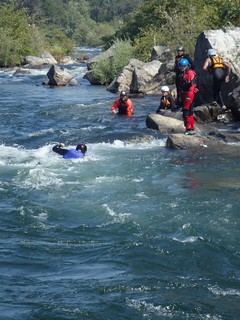
You should take this course
First, I highly recommend this class for anyone who spends time around water, or in the backcountry. The rest of my family nearly died on a backpacking trip not all that long ago up in the white mountains when they got caught by a hurricane (I wasn't with them on that trip). The tiniest of rivulets grew into barely crossable rivers. Steep hillsides became 6 inch deep running water across the whole hillside. They had to do *many* river crossings on or past the boundary of reasonable safety just to get out from where trees were falling around them threatening to kill them another way. My family did it and got out alive. This situation is not that likely, but now I can look at that river and judge when I will lose my footing, or whether I can swim it based on having actually been in rapids. This is a really good thing in my mind.
In other words, if you read this blog with intent to DO any of the stuff we do, this course is probably for you.
Sierra Rescue
Second, a shout out to the Sierra Rescue folks. Julie and Don were both amazing. One of the fireman in the class said it was the single best class he'd every taken. I don't know if I can qualify it that broadly (I'm lucky to have taken a lot of really good classes), but it was extremely well taught, and a lot of fun, and I learned tons.
The course
So, what is a Swiftwater Rescue Technician course? The course is aimed basically at two demographics. The first is professional rescuers (e.g. fireman) who might have as part of their jobs to pull people out of rivers. The other is lay-people who work around rivers and bodies of water and are likely to end up performing a rescue of opportunity. For example white-water raft guides, or folks who work for fish and wildlife.
The class started off with understanding the river. The had us swim around quite a bit in class 2 rapids. The idea is to understand how the river moves, where the eddies are, and how you can use all that to your advantage. One big surprise for me is that while being a strong swimmer is helpful, it's absolutely not necessary. Basically, if you are crossing a fast-moving river you need to swim effectively enough to move significantly slower than the river. Then you use the river's current to push you across by angling your body properly. As long as you are going slower than the river you'll succeed in moving sideways. Similarly sometimes you go faster swimming downriver, the main goal is just to be going faster so you have some momentum to punch past things that would stall you if you moved at the speed of the river. This is so much the case actually that probably the strongest swimmer in the class had the most trouble. They had to get over the idea that they could just swim where they wanted to go. The photo at the top is of someone learning to swim through the wall of an eddy using a barrel roll.
Next we did wading. One of the keys to swiftwater is to *never* put your feet down if you are moving. You don't put your feet unless you are absolutely still. So wading is okay as long as you aren't moving at all. The idea is that most swiftwater rescues are hands-on. The instructors theory is that you have a very very short time to get the person's head above water. If you have to do anything technical chances are it's going to be a recovery and not a rescue. So if you possibly can do it safely, just get in and get hands on. The picture below is of us using a wedge technique, this is great for creating a giant eddy behind you for someone else to work, or to drag a victim across.

Then we did throwbags, which they stressed are useful but are way overused and overtrusted. One of the things this drove home to me is that if you expect to save someone with a throwbag, you darned well better practice a LOT. It's easy on land, it's really hard in the river. Another interesting thing to note is that generally you don't haul the person in, instead you just hold the rope, often letting out a little slack to swing them to shore, preferrably in a nice eddy.
Another rule of the swiftwater rescue is you never tie anyone to anything. Their are two exceptions. The first is a live-bait harness on your lifejacket. The second is a victim who will probably drwon if you lose them. The live bait jacket is a specially designed quick-release loop of webbing so you can drop whatever is tied to you if something goes wrong. It's called live-bait I think because it's usually used to tie a rescuer to a throw-bag. The rescuer then jumps in... so they are in the water on the end of a line, like bait on a hook. This is super awesome for deeper water. Instead of hoping your victim will grab a rope you can just jump in and grab them directly, then have your mates on shore swing you back into shore.
This picture is of two people helping pull one over and off of a strainer (the rope in the picture is holding the strainer in place, not a person).

We also went over using boats, and paddling boats around the river. By this time Julie had discovered that I was thinking of doing some raft guiding eventually and decided to teach me how to raft. I've canoed and whitewater kayaked before. The boat moves a bit differently, but it's basically the same
Even more fun than the boats is using riverboards which we practiced surfing on to help build a better understanding of the river and currents. A riverboard is like an extra floaty boogy board. You wear flippers with it and move through the river using the flippers and often your arms as well. You can surf standing waves with them. They are in fact used for rescue as it gives you something to hand the victim when you get to them so they jump on that instead of drowning you. It also gives you a great view of the river.
And of course we covered some rope stuff. They stressed that generally ropes aren't the answer, but if you can't get in the water or use a boat safely you don't have a choice. We practiced pulling someone's head out of the water with a rope in the case of a foot entrapment, and then trying to free their foot with a second rope. We did this with Julie actually in the water pretending to drown. We also practiced pulling someone off a strainer (one of the rare cases where it's okay to tie something to them... in this case we laso'd them under the arms). And we practiced lasoing someone who was going down a river.
This is the easy way to cross a river (if you already have a tension diagonal line):
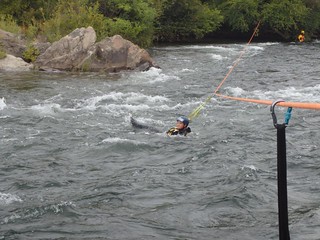
Overall the biggest thing with ropes is understanding how angles multiply forces and using that to your advantage. I already knew this from technical ropes, though even then one trick (mentioned in the swiftwater course) I only picked up due to discussions with another nerd in CalESAR. If you take a rope and pull it taught between two objects, if you push sideways on the center of the rope your force is multiplied infinitely. As you push sideways the angle decreases and the factor drops. By 120 degrees it's 1:1. This is really bad if you are trying to hold a rope straight and something (like a person in a river) is pulling it in the middle, and you need to account for it. On the other hand it's awesome if you want to move a car and all you have is a long rope.
We also did a bunch of scenerios. We had two groups for most of the time, my group was working with Julie, while the fireman worked with Don. Julie and Don are both white-water rafters having done a TON of rafting. Don has done first ascents all over the world. Don is also a firefighter though, and being male tends to use more... macho techniques, so that fit made sense. Julie is actually the owner of Sierra Rescue. Anyone, our group spent our time saving Julie for the most part, wading in and dragging her out, swimming her out, lasoing her, etc. We did live-bait and swim-outs with each other as well. At the end we did a scenerio with everyone.... We basically "killed" everyone (oops), the mistake was trusting one of the victims to help (the rescuers had him paddling). I was one of the backup's with a throwbag downriver - though was upriver from where everyone "died".
Final takeaways:
- I'm a LOT more comfortable around rivers and fast-moving water now that I have the ability to judge what is safe.
- I'm probably going to try whitewater raftguiding sometime. 'cause I mean... why not?
- Everyone who spends time around water OR in the backcountry should take this course. Seriously, how much do you spend on gear? For a surprising number of people this is a drop in the bucket compared to their gear budget.
- Physics is awesome, and so is water.
Here's more photos: https://www.facebook.com/sierra.rescue.7/media_set?set=a.566404206753427.1073741881.100001515572160&type=3
Stone age pack list
2013-08-21
Author: Jess
The time to actually go out in the wilderness is coming up soon, so I thought I'd give you all a glimpse of my pack.
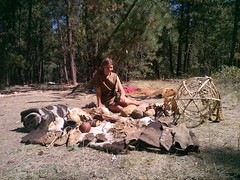
(Edit: mbrewer added the photo)
here's the list:
Clothing:
Buckskin tunic
Buckskin skirt
Buckskin leggings (basically pants without the crotch, which attach to the garter belt to keep up)
Garter belt (not pictured, for holding up leggings and menstral pads)
Felt vest with buckskin sleeves (borrowed)
Two tanned adult coyotes to be tacked into a rough vest with buckskin thong
Tanned coyote puppy to be sewn into a hat
Barktan belt
Foot wear:
Rawhide buffalo sandals
Moccasins
Broughs
Felt booties (For cold weather)
Food:
5.75 pounds of dried berries
About the same amount of dried buffalo meat
About 6 cups of dried mussels
2 cups mussel bullion
a handful of roots
a few California bay leaves
a bit of salt
A coconut of duck fat
A gourd of maple syrup!
Other things I'm forgetting. :)
Bedding:
Felt blanket (7.6 pounds, which is on the thin side)
Tanned sheep skin
Other:
Pack basket (Dogwood staves, rawhide netting, buckskin and felt pack straps and buckskin tump line)
Clay pot (borrowed, mine broke in the firing)
Coconut bowl
Alligator juniper spoon
Fire kit (Salmon skin wrap, hand drill kit made of buckeye and canadian flea bane, bow drill kit)
Journal (One of the not stone age items)
Menstral pad (Not pictured, Stuff with dry moss and tie to garter belt to use)
Bow (Beautifully handmade by Brewer out of hickory. The string isn't primitive and I don't have any arrows, so it's not super practical... especially since I can't draw it to full draw length yet, but I want to bring it so I will assuming the pack isn't too heavy)
A water gourd
Tool kit:
Bone fish hooks (horse mane will be used for the line)
Bone awl (for mending)
Cattail fluff for tinder
Bow drill socket (borrowed)
Mussel shell (for drinking from very small streams)
Save pot with deer fat, bear fat, yarrow, plantain save
It currently weighs in at 24 pounds before the food and bow. Not ultra light, but not as heavy as I expected
Things I'd like to have that I don't:
A more reliable way to start fires. Hand and bow drill can be really reliable, but I need to practice more to get there.
A hip belt. These basket packs just don't really work with a hip belt in any simple way so I'll have to make do with the tump line and shoulder straps
In less happy news one of the two goats in camp fell and tore the ligament in his leg. He'll probably have to be put down as fully severed ligaments don't generally heal without surgery and his job in life is to be a pack goat. He's a sweety though and it's really sad to see him go.
Anyway, to the mountains! See you next month.

